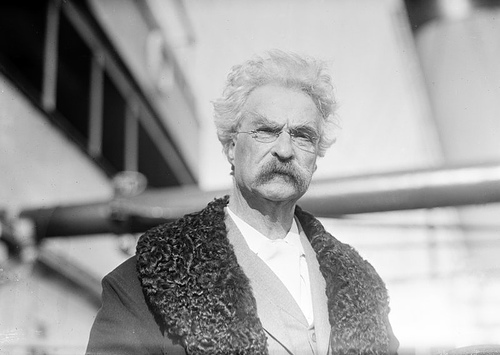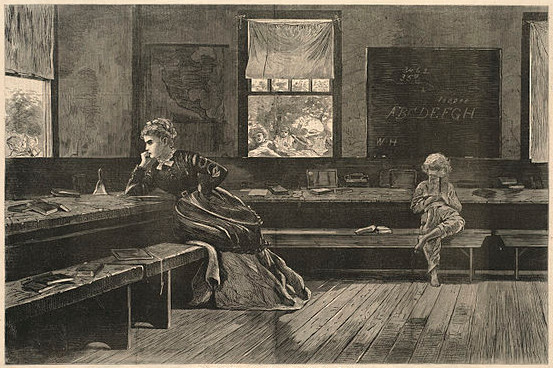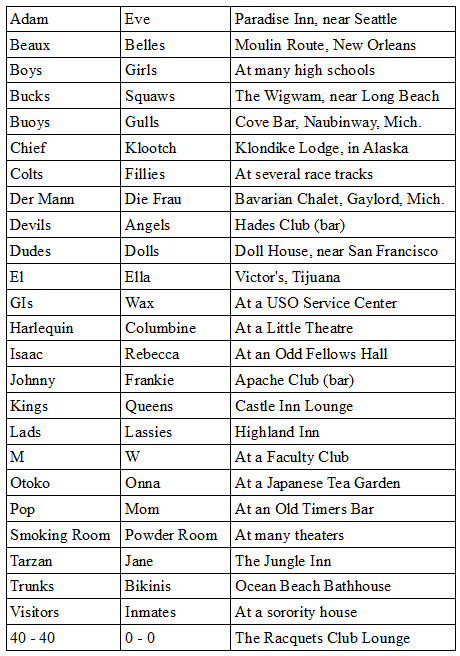The Indonesian word for water is air.
The Czech word for guest is host.
The Basque word for cold is hotz.
The Hebrew word for she is he.
(Thanks, Alec and Daniel.)
The Indonesian word for water is air.
The Czech word for guest is host.
The Basque word for cold is hotz.
The Hebrew word for she is he.
(Thanks, Alec and Daniel.)

“The German long word is not a legitimate construction, but an ignoble artificiality, a sham,” wrote Mark Twain. “Nothing can be gained, no valuable amount of space saved, by jumbling the following words together on a visiting card: ‘Mrs. Smith, widow of the late Commander-in-chief of the Police Department,’ yet a German widow can persuade herself to do it, without much trouble: ‘Mrs.-late-commander-in-chief-of-the-police-department’s-widow-Smith.'” He gives this anecdote in his autobiography:
A Dresden paper, the Weidmann, which thinks that there are kangaroos (Beutelratte) in South Africa, says the Hottentots (Hottentoten) put them in cages (kotter) provided with covers (lattengitter) to protect them from the rain. The cages are therefore called lattengitterwetterkotter, and the imprisoned kangaroo lattengitterwetterkotterbeutelratte. One day an assassin (attentäter) was arrested who had killed a Hottentot woman (Hottentotenmutter), the mother of two stupid and stuttering children in Strättertrotel. This woman, in the German language is entitled Hottentotenstrottertrottelmutter, and her assassin takes the name Hottentotenstrottermutterattentäter. The murderer was confined in a kangaroo’s cage — Beutelrattenlattengitterwetterkotter — whence a few days later he escaped, but fortunately he was recaptured by a Hottentot, who presented himself at the mayor’s office with beaming face. ‘I have captured the Beutelratte,’ said he. ‘Which one?’ said the mayor; ‘we have several.’ ‘The Attentäterlattengitterwetterkotterbeutelratte.’ ‘Which attentäter are you talking about?’ ‘About the Hottentotenstrottertrottelmutterattentäter.’ ‘Then why don’t you say at once the Hottentotenstrottelmutterattentäterlattengitterwetterkotterbeutelratte?’
He calls the long word “a lazy device of the vulgar and a crime against the language.”

pensum
n. a piece of schoolwork imposed as a punishment
tongue-shot
n. speaking or talking distance, voice-range
Inhabitants of La Gomera, a small mountainous island in the Canary group, use a whistled language called the Silbo to communicate over great distances. “This is a form of telephony inferior to ours as regards range, but superior to it in so far as the only apparatus required is a sound set of teeth and a good pair of lungs,” noted Glasgow University phoneticist André Classe in New Scientist in 1958. “The normal carrying power is up to about four kilometres when conditions are good, over twice as much in the case of an exceptional whistler operating under the most favourable circumstances.”

greenswardsmanship
n. the cultivation of an unusually and enviably excellent lawn
The interactive installation Text Rain (1999), by Camille Utterback and Romy Achituv, invites participants to view themselves on a monitor while letters rain down upon them. “Like rain or snow, the text appears to land on participants’ heads and arms. The text responds to the participants’ motions and can be caught, lifted, and then let fall again. The falling text will land on anything darker than a certain threshold, and ‘fall’ whenever that obstacle is removed.”
The letters aren’t random — they form the poem “Talk, You,” from Evan Zimroth’s 1993 book Dead, Dinner, or Naked:
I like talking with you,
simply that: conversing,
a turning-with or -around,
as in your turning around
to face me suddenly …
At your turning, each part
of my body turns to verb.
We are the opposite
of tongue-tied, if there
were such an antonym;
We are synonyms
for limbs’ loosening
of syntax,
and yet turn to nothing:
It’s just talk.
“If a participant accumulates enough letters along their outstretched arms, or along the silhouette of any dark object, they can sometimes catch an entire word, or even a phrase,” the artists note. “‘Reading’ the phrases in the Text Rain installation becomes a physical as well as a cerebral endeavor.”

haliography
n. a description of the sea
Charles Dickens’ 1850 novel David Copperfield climaxes with a dramatic tempest at Yarmouth:
The tremendous sea itself, when I could find sufficient pause to look at it, in the agitation of the blinding wind, the flying stones and sand, and the awful noise, confounded me. As the high watery walls came rolling in, and, at their highest, tumbled into surf, they looked as if the least would engulf the town. As the receding wave swept back with a hoarse roar, it seemed to scoop out deep caves in the beach, as if its purpose were to undermine the earth. When some white-headed billows thundered on, and dashed themselves to pieces before they reached the land, every fragment of the late whole seemed possessed by the full might of its wrath, rushing to be gathered to the composition of another monster. Undulating hills were changed to valleys, undulating valleys (with a solitary storm-bird sometimes skimming through them) were lifted up to hills; masses of water shivered and shook the beach with a booming sound; every shape tumultuously rolled on, as soon as made, to change its shape and place, and beat another shape and place away; the ideal shore on the horizon, with its towers and buildings, rose and fell; the clouds fell fast and thick; I seemed to see a rending and upheaving of all nature.
Tolstoy wrote, “If you sift the world’s prose literature, Dickens will remain; sift Dickens, David Copperfield will remain; sift David Copperfield, the description of the storm at sea will remain.” The scene formed the conclusion of Dickens’ public readings from the novel, and was often hailed as the grandest moment in his performances. Thackeray’s daughter Annie said the storm scene was more thrilling than anything she had ever seen in a theater: “It was not acting, it was not music, nor harmony of sound and color, and yet I still have an impression of all these things as I think of that occasion.”
Most restrooms use simple labels such as MEN and WOMEN, but some are more creative. R. Robinson Rowe shared his collection in Word Ways in February 1977:

He added, “I was reminded of an incident at the treaty congress in San Francisco in 1952, when Japanese delegates unfamiliar with our language were briefed on the nomenclature of hotel restrooms: MEN would be a shorter word than WOMEN. An amused press reported their confusion and embarrassment when they were lodged in a posh hotel with facilities labelled GENTLEMEN and LADIES.”

advesperate
v. to grow dark, to become night
In 1948 Melvin Wellman discovered this pretty anagram:
ELEVEN + TWO = TWELVE + ONE
And Dave Morice found this:
THIRTEEN + TWENTY – ONE = (NINETY / TWO) – TEN – THREE
Lee Sallows discovered two similar specimens in Spanish:
UNO + CATORCE = CUATRO + ONCE
DOS + TRECE = TRES + DOCE
These can be combined to make more:
UNO + DOS + TRECE + CATORCE = TRES + CUATRO + ONCE + DOCE
UNO + TRES + DOCE + CATORCE = DOS + CUATRO + ONCE + TRECE